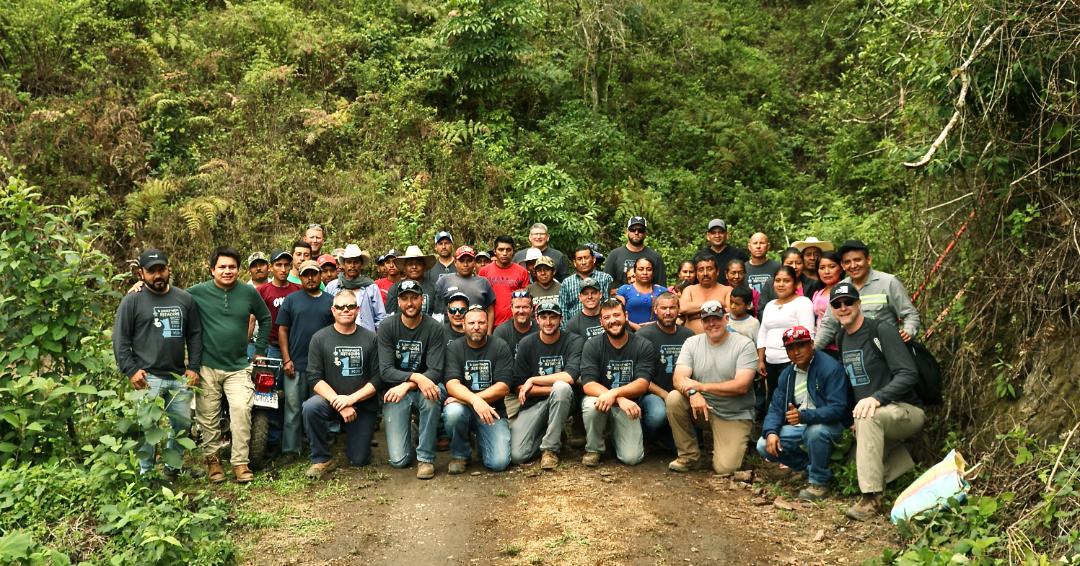Cooperative lineworkers to help electrify Guatemalan villages

The lineworkers from Minnesota and Iowa are used to working hard in some rough conditions, but this two-week trip in June pressed them to new limits. The ride to the village, after the staging area at a local ranch, was grueling. To get to the village, the team spent one hour bouncing over rocks, splashing through puddles, straddling washouts, spinning through ruts and sliding on the wet red clay road that hadn’t even existed four weeks earlier. The rain, coming in sheets at times or as a lingering grey mist, kept the road slick and travel slow, and caused the team to walk the last mile into the village on a couple of days.
“The terrain was harder than I thought it was going to be,” Grant Kulzer, Stearns Electric Association, said. “It rained every night.”
The village of Las Peñas, at an elevation of around 6,000 feet, is made up of about 35 homes scattered on the crests and flat areas of the mountainside. The people — ranging from nursing infants to those with grey hair and weathered skin — live in the mountain village, and most of them are farmers. Not farmers with heavy equipment and modern conveniences, but tilling the soil, planting corn, building fences, spraying weeds, harvesting corn, coffee beans and other crops — all by hand without modern machinery to help with the work.
Working by hand is the way of life in this area and — at least for a short time — the way of life for the lineworkers, who traveled 2,800 miles to build more than three miles of line to bring electricity that will improve the lives of these families for generations.
Poles were set by hand, transformers hoisted up by pulley and wire pulled from one pole to the next by willing villagers. The locals were ready to step in and work. “They were eager to help,” Steve Dvergsten from Sioux Valley Electric, said of the locals.
“They pulled all the wire straight down the mountainside and straight back up the other side,” Mike Berkenpas, Iowa team lead from North West REC, said.
The village is served by the local municipality, which will manage the lines now that they are built. Having electricity will bring meaningful change to the people in the village. In rural villages, often just the boys are in school. Girls don’t typically attend school because of the time it takes to do housework and food preparation. In locations where electricity has been installed, the girls can then attend school with the boys. Many other changes come as well: better health, fewer open fires, refrigeration of food, economic growth and more.
“Electricity is going to bring them a better education and a better life,” Willy, one of the team’s translators, said.
Along with building the line, the crews also wired the houses with a couple of outlets and light bulbs. Walking from each home was a workout, as the village is scattered at different elevations on the mountainside.
Berkenpas spoke to some villagers. Some younger boys were excited just to have light, so they wouldn’t have to use candles, while another man in his 50s said he can’t wait to get a refrigerator so he can keep food.
On the last day up the mountain, the crews met the villagers outside the village for a small ceremony. Scott Meinecke from the Iowa Association of Electric Cooperatives spoke on behalf of the team. He thanked the villagers and said it was a pleasure to come and serve them. He acknowledged that the work would not have gotten done without the villagers’ help.
The leader of the village spoke on behalf of the community and shared their gratefulness to the team. “Thank you to everyone who helped,” he said. “You bring happiness for the hope that we can do more now with electricity.”
During an interview, one woman summed it up nicely: “I am grateful that you came here to visit. It is a grand day that you installed electricity here.”
List of volunteers
Ben Hoyt, Lake Country Power, MN
Wiley Harris, Minnesota Valley Electric Cooperative, MN
Ryan Loomans, Nobles Cooperative Electric, MN
Eric Dessner, People’s Energy Cooperative, MN
Steve Dvergsten, Sioux Valley Energy, MN
Grant Kulzer, Stearns Electric Association, MN
Jason Donnelly Allamakee-Clayton Electric Cooperative, IA
Brian Reidy, East-Central Iowa Rural Electric Cooperative, IA
Andy Koopman, Eastern Iowa Light & Power Cooperative, IA
Bailey Bausch, Maquoketa Valley Electric Cooperative, IA
Tanner Dreier, Midland Power Cooperative, IA
Mike Berkenpas, North West Rural Electric Cooperative, IA
Hunter Venz, Prairie Energy Cooperative, IA
The trip was part of National Rural Electric Cooperative Association’s (NRECA) International Program, which has been providing volunteers to illuminate villages and homes in impoverished countries around the world since 1962. The program has been working in Guatemala since 2011 and volunteer workers have brought electricity to more than 7,000 people in rural communities. The teams that went on behalf of all of Minnesota’s and Iowa’s electric cooperatives, couldn’t have done the work without the generosity of many donors, vendors, cooperatives and individuals who wanted to support the work.
The Minnesota Rural Electric Association, along with Iowa Association of Electric Cooperatives, helped organize the trip. You can see photos and videos from the trip if you join the dedicated Facebook group (http://www.facebook.com/groups/2094274217615477/), “2024 Powering a Brighter Future in Guatemala.”
If you would like to support the project and future projects, you can donate through PayPal at http://tinyurl.com/4ffkxmms.
